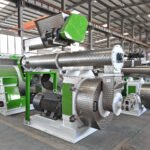Catfish farming is a vital component of aquaculture, and producing high-quality catfish feed is essential for successful operations. Fish feed pellet making machines are crucial for processing catfish feed efficiently and effectively. This article outlines the steps involved in producing catfish feed with fish feed pellet making machines, emphasizing key considerations, processes, and best practices.
Understanding Catfish Nutritional Requirements
Before diving into the feed production process, it’s important to recognize the nutritional needs of catfish:
- Protein Content: Catfish require a diet consisting of 28-32% protein for optimal growth.
- Fat Content: The diet should include lipids at 5-6%.
- Carbohydrates: Catfish can efficiently utilize carbohydrates, which should account for 25-30% of their diet.
- Vitamins and Minerals: A balanced mix of essential vitamins and minerals is vital for catfish health.
Raw Materials for Catfish Feed
Typical ingredients used in catfish feed production include:
- Soybean meal
- Corn or wheat
- Fish meal (used sparingly)
- Rice bran
- Vegetable oils
- Vitamins and minerals
- Binders and additives

Steps to Produce Catfish Feed with Fish Feed Pellet Making Machines
- Raw Material Preparation:
- Grind the ingredients to a uniform particle size (typically 250-300 microns) using a hammer mill or pulverizer.
- Ensure the moisture content is appropriate (typically 10-12%) for optimal pellet formation.
- Ingredient Mixing:
- Use a mixer to blend all ingredients thoroughly for 5-10 minutes.
- Gradually add liquid ingredients (such as oils or molasses) to ensure even distribution.
- Conditioning:
- Pre-condition the mixed ingredients with steam to achieve proper moisture and temperature.
- Aim for a temperature of 80-90°C and a moisture content of 16-18%.
- Extrusion:
- Feed the conditioned mixture into the fish feed pellet making machine (extruder).
- Set the extruder parameters:
- Temperature: 110-130°C
- Pressure: 30-40 atmospheres
- Screw speed: Adjust based on desired pellet characteristics.
- Pellet Formation:
- As the mixture passes through the extruder die, it forms into pellets.
- Adjust the die size to produce pellets suitable for various growth stages of catfish (typically 2-8mm).
- Cutting:
- Use a rotary cutter to cut the extruded material into uniform pellet lengths.
- Drying:
- Dry the pellets to reduce moisture content to 8-10% using a multi-layer dryer with controlled temperature and airflow.
- Cooling:
- Allow the pellets to cool to room temperature using a counter-flow cooler.
- Coating (optional):
- Apply a coating of fish oil and other additives (such as vitamins) using a vacuum coater if required.
- Packaging:
- Package the cooled pellets in appropriate bags or containers.
Key Considerations for Catfish Feed Processing
- Pellet Density: Adjust extruder settings to achieve the desired pellet density, typically producing sinking pellets for catfish.
- Water Stability: Ensure the pellets maintain integrity in water for at least 15-20 minutes; proper binding and extrusion parameters are crucial for this.
- Nutritional Integrity: Monitor the temperature during processing to prevent nutrient degradation, and consider post-extrusion coating for heat-sensitive additives.
- Pellet Size and Uniformity: Produce pellets of consistent size and shape for even feeding and reduced waste by adjusting die size and cutter speed.
- Digestibility: The extrusion process can enhance the digestibility of plant-based ingredients; monitor starch gelatinization for optimal results.
- Sinking Properties: Ensure pellets sink appropriately based on catfish feeding behavior, adjusting formulation and processing parameters accordingly. (Related post: floating fish feed machine)
Optimizing the Fish Feed Pellet Making Machine for Catfish Feed
- Screw Configuration: Utilize a screw design that provides adequate mixing and shear for catfish feed ingredients; consider a twin-screw extruder for better control.
- Die Design: Select die hole sizes and land lengths that suit the desired pellet characteristics, using a die with a larger length-to-diameter ratio for enhanced pellet durability.
- Temperature Profile: Gradually increase the temperature along the extruder barrel, monitoring and adjusting temperatures to optimize cooking without degrading nutrients.
- Moisture Control: Implement moisture sensors and control systems to maintain consistent moisture levels, adjusting steam addition in the preconditioner as needed.
- Pressure Control: Monitor and manage pressure within the extruder to achieve desired density and sinking properties.
- Cutting Mechanism: Employ a high-speed rotary cutter for clean, uniform pellet lengths, adjusting cutter speed relative to extruder output for consistency.
Quality Control Measures
Implement the following quality control measures to ensure high-quality catfish feed:
- Conduct regular ingredient analysis to verify nutritional content.
- Monitor moisture, temperature, and pressure throughout the production process.
- Test pellet durability using a Holmen tester or similar device.
- Perform water stability tests to confirm that pellets maintain their integrity in water.
- Analyze finished pellets to confirm they meet nutritional specifications.
- Schedule regular equipment maintenance and calibration.
Challenges and Troubleshooting
Common challenges in catfish feed production and their solutions include:
- Inconsistent Pellet Quality: Adjust extruder parameters, check ingredient consistency, and ensure thorough mixing.
- Poor Water Stability: Optimize binder levels, adjust extrusion temperature and pressure, and consider using pre-gelatinized starch.
- Nutrient Loss During Processing: Monitor processing temperatures and consider post-extrusion coating for sensitive nutrients.
- Pellet Breakage: Adjust die design, optimize drying processes, and improve cooling methods.
Conclusion
Producing catfish feed with a fish feed pellet making machine requires a comprehensive understanding of catfish nutritional needs, careful selection of ingredients, and precise control of the extrusion process. By following the outlined steps and considering the key factors that influence feed quality, producers can create high-quality catfish feed that supports optimal growth and health in farmed catfish.
Regular monitoring, quality control, and optimization of machinery are essential for consistently producing superior catfish feed pellets. As the aquaculture industry continues to expand, the demand for efficient and high-quality catfish feed production will rise. By mastering the catfish feed production process using fish feed pellet making machines, producers can meet this demand while enhancing feed efficiency and sustainability in catfish farming operations.











